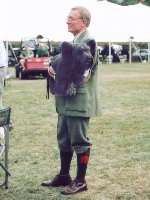Picking it Up
(April 2012) That’s right — we’re talking about dog poop. If any of you are squeamish, or always leave it to the help to deal with this sort of thing, you might want to look away now.
Still here? Good. Let’s carry on.
It doesn’t take a psychiatrist to figure out why we pick up dog poop from our yards. We need to have a space that’s free of that stuff, because obviously
- we don’t want to step in it (frequently leads to swearing),
- we don’t want visitors stepping in it (swearing, followed by apologies and fibs),
- we don’t want to smell it (see Appetite, the Spoiling of),
- we don’t want our dog recycling it (we shall pause briefly to allow you to think about this),
- we don’t want to deal with the flies it attracts (although a thriving cottage industry has evolved to service this need),
- we don’t want to repeat this: poop, rain, puddles, dogs, giardia, worse poop (once is more than enough),
As an aside, we once had a tree service remove some over-mature trees from the back yard. First the owner came to do an estimate. As he left, he told us that we passed the test; we had dogs and he had clean shoes. Why was this noted? He said that if he didn’t leave with clean shoes the estimate would have been 10% higher.
Unfortunately, the very act of picking it up frequently leads to the dread poop-foot, and when that happens, one can be so distracted that one pays more attention to the foot than to the ground and much that should be picked up is either overlooked completely, or worse, winds up on the other shoe. Yes, that’s double dread poop-foot, and even I’m getting disgusted at this point.
So, how do we deal with this? In fact, there are a few simple principles which can be used to avoid that unpleasantness. I’ll call them Rules because principles tend to get treated a lot like suggestions, and these are not just suggestions.
Unless you like getting the dread poop-foot.
Rule #1
Look where you step. Step where you look. Okay, maybe that’s two rules, or 1a and 1b, but they are a team, and if you violate either one you will wish you had paid better attention to Rule #2. Now, Rule #1 is so obvious that you are probably asking yourself “Why is he even mentioning this?” which is a very good question. The answer is simple. Almost every case of the dread poop-foot — I would like to say every case but I’m sure there must be exceptions — is directly due to a lack of observance of Rule #1.
Not to change the subject, but do you understand the problem with typing messages on your cell phone while you drive? Assuming that you yourself are an excellent driver, but are unsure why texting while driving is a bad idea, let’s just say that doing so increases the odds of becoming intimately acquainted with things like sidewalks, trees, and cars whizzing through green lights as if it were their God-given right to do so.
“Look where you step” is sort of like that. You’ve got to see where you’re about to put your foot, and you’ve got to be sure that no poop is in the landing zone.
Now that you’ve got a clear site in view, “Step where you look” means that you actually put your foot there. You might be surprised at the number of people who look one way then go another. Kind of like seeing a clear road straight ahead yet swerving into the ditch. In a car, it’s a crash; in the yard, it’s an invitation to the dread you-know-what.
I have a confession to make. There’s really only one rule, and this was it. If you obey Rule #1, everything else is just advice. If you don’t obey Rule #1, nothing else can save you.
Shoes
If there were a Rule #2, this would be it: Wear shoes that are easily cleaned. Or that can be left outside for a few days. Someday you are going to violate Rule #1. We all do, sooner or later. The attention wanders. A leaf turns out to be not a leaf. Autumn is my favorite season, but I can assure you that a wet fall day is not your friend if you are trying to avoid the dread poop-foot.
Muck boots are best, especially if you have more than one dog, but any shoe that can be cleaned with a hose is good.
Sport shoes with intricate patterns of deep treads are problematic to say the least. Even if they are washable, getting the poop out of all the nooks and crannies can lead one to try turning down the pressure on the pressure washer to blast it out. Another tactic is to set the shoes somewhere safe in the hope that the matter will dry up. After it dries, banging the shoe on the ground (a brick patio works nicely) should dislodge the offending crust.
Patterns
Work a pattern. A pattern is the best way to ensure that you cover all the ground. You do want to cover all the ground, don’t you, for that’s the only way to get it all picked up so that none of the bad things that we discussed earlier happen to you, your visitors, or your dogs.
You should try to approach each spot of ground from at least two directions. Frequently we find that a piece of poo we missed at first is clearly visible on the return trip. This has many causes; a bit of overgrown grass blocks your view, the sun in your eyes glares over the scene, the coloring or shape of the specimen blends in with the background when seen from from one direction but not from another. If you have a dog with a sense of humor — or a malicious streak — they may even enjoy leaving a new deposit behind you as you walk. The second pass is clearly your only advantage over such a beast.
Little Ones
Pick up the little ones first. This is especially important if your dog spins or wanders while attending to business. The little ones can be much more dangerous, especially if they’ve managed to move a little away from the main body of work.
Picking up the big ones is always satisfying, but the little ones will use any opportunity to roll under grass or a leaf or off to the side and wait for you to violate Rule #1. The big ones are slower, and thus likely to still be there after you’ve corralled the small-fry.
Don't let your eagerness to get the prize cause you to forget Rule #1!
Finally
Sherlock Holmes wrote a monograph in which he detailed the characteristics of the ash from over a hundred and forty varieties of tobacco. He included color plates to visually demonstrate the differences. I have not followed his example here, for not only would the result be too long to fit comfortably into a single web page, but I fear that the details and photos necessary to accurately describe the subject would almost certainly be too much for the casual reader to bear.
Maybe next time.
“The earth trembled and a great rift appeared, separating the first man and woman from the rest of the animal kingdom. As the chasm grew deeper and wider, all the other creatures, afraid for their lives, returned to the forest — except for the dog, who after much consideration leapt the perilous rift to stay with the humans on the other side. His love for humanity was greater than his bond to other creatures, he explained, and he willingly forfeited his place in paradise to prove it.”
—Native American folktaleFrom The Lost History of the Canine Race by Mary Elizabeth Thurston, Andrews and McMeel, Kansas City, 1996.



